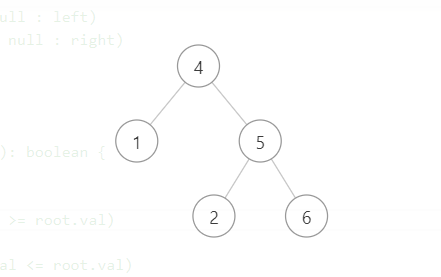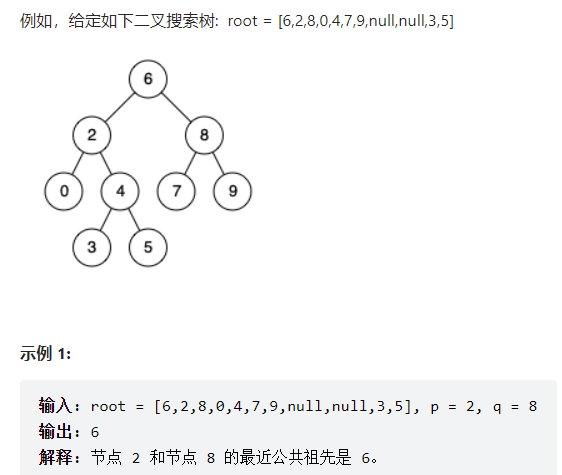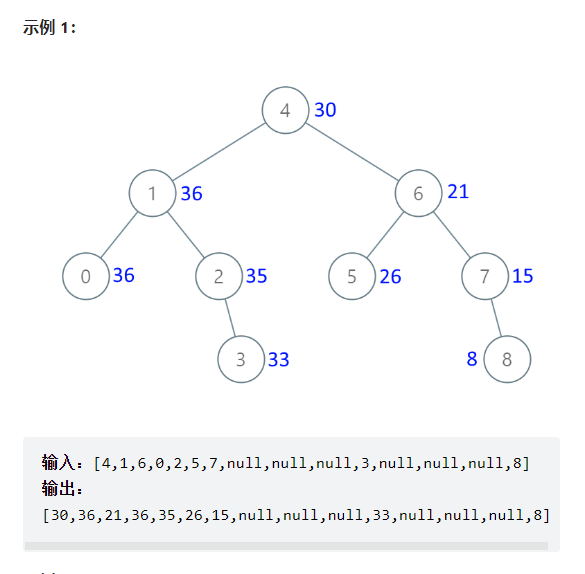-
TypeScript算法题实战——二叉搜索树篇
二叉搜索树,也叫二叉查找树、二叉排序树,是具有下列性质的二叉树: 若它的左子树不空,则左子树上所有结点的值均小于它的根结点的值; 若它的右子树不空,则右子树上所有结点的值均大于它的根结点的值。
注意:二叉搜索树中序遍历的结果是有序的
本系列博文将通过一些力扣算法题目学习TypeScirpt,这篇将以二叉搜索树为主题边学习TypeScipt边实战算法。(部分算法思想参考于程序员Carl:代码随想录)一、判断二叉搜索树
1.1、题目描述
力扣链接:https://leetcode.cn/problems/validate-binary-search-tree/
给你一个二叉树的根节点root,判断其是否是一个有效的二叉搜索树。有效 二叉搜索树定义如下:
节点的左子树只包含 小于 当前节点的数。
节点的右子树只包含 大于 当前节点的数。
所有左子树和右子树自身必须也是二叉搜索树。1.2、题解
本题有一个极容易掉进的陷阱:不能单纯的比较左节点小于中间节点,右节点大于中间节点。
因为,可能存在一种情况就是,虽然对每个节点来说左子节点都小于右子节点,但左子树不一定都小于右子树,如:

因为二叉搜索树要判断的是左子树的点一定都小于右子树的点。
这一题最直观的方法就是中根遍历,只要遍历出的数组是递增的,则满足二叉搜索树:function isValidBST(root: TreeNode | null): boolean { const traveseArr: number[] = []; if(root === null) return true; else traverse(root); function traverse(root: TreeNode | null){ if(root === null) return; traverse(root.left); traveseArr.push(root.val); traverse(root.right); } for (let i = 0, length = traveseArr.length; i < length - 1; i++) { if (traveseArr[i] >= traveseArr[i + 1]) return false; } return true; }- 1
- 2
- 3
- 4
- 5
- 6
- 7
- 8
- 9
- 10
- 11
- 12
- 13
- 14
- 15
- 16
- 17
二、二叉搜索树中的众数
2.1、题目描述
给你一个含重复值的二叉搜索树(
BST)的根节点root,找出并返回BST中的所有 众数(即,出现频率最高的元素)。如果树中有不止一个众数,可以按 任意顺序 返回。
假定
BST满足如下定义:结点左子树中所含节点的值 小于等于 当前节点的值
结点右子树中所含节点的值 大于等于 当前节点的值
左子树和右子树都是二叉搜索树力扣链接:https://leetcode.cn/problems/find-mode-in-binary-search-tree
2.2、题解
首先使用任意遍历方法将树遍历(前、中、后或者层序),然后将遍历出的数字都存入数组当中。
问题就变成了求一个数组当中的众数,要注意的是这个数组里可能有多个众数,即出现同样次数的数字不止一个,比如1,2,2,2,3,3,3或者1,2,2,3,3,4。
要求众数,我们可以用到哈希Map,算出数组内所有数出现的次数,我们设计一个存储出现次数的哈希Map,遍历一遍:
for(let i = 0; i < traveseArr.length; i++){ countMap.set(traveseArr[i], (countMap.get(traveseArr[i]) || 0) + 1); }- 1
- 2
- 3
key表示出现的数字,value表示对应出现的次数,然后找到出现次数最多的key输出就好了。题解:
function findMode(root: TreeNode | null): number[] { if (root === null) return []; const countMap: Map<number, number> = new Map(); const traveseArr: number[] = []; traverse(root); function traverse(root: TreeNode | null){ if(root === null) return; traverse(root.left); traveseArr.push(root.val); traverse(root.right); } for(let i = 0; i < traveseArr.length; i++){ countMap.set(traveseArr[i], (countMap.get(traveseArr[i]) || 0) + 1); } const countArr: number[][] = Array.from(countMap); countArr.sort((a, b) => { return b[1] - a[1]; }) const resArr: number[] = []; const maxCount: number = countArr[0][1]; for (let i of countArr) { if (i[1] === maxCount) resArr.push(i[0]); } return resArr; };- 1
- 2
- 3
- 4
- 5
- 6
- 7
- 8
- 9
- 10
- 11
- 12
- 13
- 14
- 15
- 16
- 17
- 18
- 19
- 20
- 21
- 22
- 23
- 24
- 25
- 26
- 27
- 28
在代码中使用到了,
const countArr: number[][] = Array.from(countMap);,可以将countMap(类型为哈希Map)转换成二维数组,数组为一个n行2列数组,第一列为出现的数字,第二列为对应数字出现的次数,这样就可以很好进行操作并得到众数了。三、求二叉搜索树的最近公共祖先
3.1、题目描述
给定一个二叉搜索树, 找到该树中两个指定节点的最近公共祖先。
百度百科中最近公共祖先的定义为:“对于有根树T的两个结点p、q,最近公共祖先表示为一个结点x,满足x是p、q的祖先且x的深度尽可能大(一个节点也可以是它自己的祖先)。”力扣链接:https://leetcode.cn/problems/lowest-common-ancestor-of-a-binary-search-tree/

3.2、题解
首先我们做一题普通二叉树的最近公共祖先,可以用递归来做,最近公共祖先有一个特点就是:p和q来自于(1)左子树,(2)右子树,(3)根节点的三者其中之二。
function lowestCommonAncestor(root: TreeNode | null, p: TreeNode | null, q: TreeNode | null): TreeNode | null { if(root == null) return root; if(root == p || root == q) return root; const left = lowestCommonAncestor(root.left, p, q); const right = lowestCommonAncestor(root.right, p, q); // 即第一次在该节点的左子树和右子树上分别找到了p 和 q if(left !== null && right !== null) return root; // 暂时只找到一个 if(left != null) return left; if(right != null) return right; // 一个都没找到 return null; };- 1
- 2
- 3
- 4
- 5
- 6
- 7
- 8
- 9
- 10
- 11
- 12
- 13
- 14
- 15
而 求二叉搜索树的最近公共祖先 需要在上一题的基础上,利用一下“二叉搜索树是有序的”这个特点,即从根开始找,如果根节点大于p也大于q,则往左子树找,如果根节点小于q也小于p,则往右子树找,如果不满足同时小于或者大于,那么他就是我们要的最近公共祖先。
function lowestCommonAncestor(root: TreeNode | null, p: TreeNode | null, q: TreeNode | null): TreeNode | null { if(root.val > p.val && root.val > q.val){ return lowestCommonAncestor(root.left, p , q); } if(root.val < p.val && root.val <q.val){ return lowestCommonAncestor(root.right, p, q); } return root; };- 1
- 2
- 3
- 4
- 5
- 6
- 7
- 8
- 9
四、二叉搜索树中的插入操作
4.1、题目描述
给定二叉搜索树
(BST)的根节点root和要插入树中的值value,将值插入二叉搜索树。 返回插入后二叉搜索树的根节点。 输入数据 保证 ,新值和原始二叉搜索树中的任意节点值都不同。注意,可能存在多种有效的插入方式,只要树在插入后仍保持为二叉搜索树即可。 你可以返回 任意有效的结果
力扣链接:https://leetcode.cn/problems/insert-into-a-binary-search-tree4.2、题解
我们选择不改变树的结构,而是往空结点里面插值,这样做就简单很多,首先判断当前根节点为不为空,若为空则新建一个值为val的结点,返回,若不为空则判断其根节点的值是大于val还是小于val,使用递归的思想,根值大于val就去改左子树,根值小于val就去改右子树。
function insertIntoBST(root: TreeNode | null, val: number): TreeNode | null { if(root == null){ let res: TreeNode = new TreeNode(val) return res; } if(root.val > val) root.left = insertIntoBST(root.left, val); else if(root.val < val) root.right =insertIntoBST(root.right, val); return root; };- 1
- 2
- 3
- 4
- 5
- 6
- 7
- 8
- 9
- 10
- 11
- 12
五、删除二叉搜索树中的节点
5.1、题目描述
给定一个二叉搜索树的根节点
root和一个值key,删除二叉搜索树中的key对应的节点,并保证二叉搜索树的性质不变。返回二叉搜索树(有可能被更新)的根节点的引用。力扣链接:https://leetcode.cn/problems/delete-node-in-a-bst
5.2、题解
一般来说,删除节点可分为两个步骤:首先找到需要删除的节点;如果找到了,删除它。我们主要把算法分成三大块:删除节点的部分、寻找待删除节点的部分,递归返回的部分。
可以利用到二叉搜索树的特性寻找到待删除节点,然后删除节点的方法是把右子树的根节点提上来带他当前节点,然后右子树的最左子节点的左节点接当前左子树。
function deleteNode(root: TreeNode | null, key: number): TreeNode | null { if (root === null) return null; //删除节点 if(root.val === key){ if (root.left === null && root.right === null) return null; else if (root.left === null) return root.right; else if (root.right === null) return root.left; // 把右子树的最左子节点续上 let curNode: TreeNode = root.right; while (curNode.left !== null) { curNode = curNode.left; } curNode.left = root.left; return root.right; } //寻找节点 else if(root.val < key){ root.right = deleteNode(root.right, key); } else if(root.val > key){ root.left = deleteNode(root.left, key); } //返回 return root; };- 1
- 2
- 3
- 4
- 5
- 6
- 7
- 8
- 9
- 10
- 11
- 12
- 13
- 14
- 15
- 16
- 17
- 18
- 19
- 20
- 21
- 22
- 23
- 24
- 25
六、修剪二叉搜索树
6.1、题目描述
给定一个二叉搜索树,同时给定最小边界
L和最大边界R。通过修剪二叉搜索树,使得所有节点的值在[L, R]中(R>=L)。你可能需要改变树的根节点,所以结果应当返回修剪好的二叉搜索树的新的根节点。
题目链接:https://leetcode.cn/problems/trim-a-binary-search-tree/6.2、题解
如果当前节点值小于low,则切除左子树以及根节点,如果当前节点值大于high,则切除右子树以及根节点,如果当前节点值在low和high的其中,那么就递归到左子树和右子树进行后续操作。
function trimBST(root: TreeNode | null, low: number, high: number): TreeNode | null { if (root === null) return null; if (root.val < low) { return trimBST(root.right, low, high); } if (root.val > high) { return trimBST(root.left, low, high); } root.left = trimBST(root.left, low, high); root.right = trimBST(root.right, low, high); return root; };- 1
- 2
- 3
- 4
- 5
- 6
- 7
- 8
- 9
- 10
- 11
- 12
七、将有序数组转换为二叉搜索树
7.1、题目描述
给你一个整数数组 nums ,其中元素已经按 升序 排列,请你将其转换为一棵 高度平衡 二叉搜索树。
高度平衡 二叉树是一棵满足「
每个节点的左右两个子树的高度差的绝对值不超过 1」的二叉树。力扣链接:https://leetcode.cn/problems/convert-sorted-array-to-binary-search-tree
7.2、题解
使用二分法加递归的思想,首先要保证高度平衡,且在满足二叉搜索树的前提下,根节点需要选择为该有序数组的中间值,然后左子树即是该值左边的部分,右子树则是其右边的部分,递归继续即可:
function sortedArrayToBST(nums: number[]): TreeNode | null { if(nums == null) return null; else return recur(nums, 0, nums.length - 1); function recur(nums:number[], left:number, right:number):TreeNode{ if(left === right){ let res:TreeNode = new TreeNode(nums[left]); return res; } if(left > right) return null; let mid = Math.floor((right + left + 1) / 2); let res:TreeNode = new TreeNode(nums[mid]); res.left = recur(nums, left, mid - 1); res.right = recur(nums, mid + 1 , right); return res; } };- 1
- 2
- 3
- 4
- 5
- 6
- 7
- 8
- 9
- 10
- 11
- 12
- 13
- 14
- 15
- 16
- 17
- 18
- 19
八、把二叉搜索树转换为累加树
8.1、题目描述
给出二叉 搜索 树的根节点,该树的节点值各不相同,请你将其转换为累加树
(Greater Sum Tree),使每个节点 node 的新值等于原树中大于或等于 node.val 的值之和。

力扣链接:https://leetcode.cn/problems/convert-bst-to-greater-tree
8.2、题解
从累加的顺序来看,很简单能看出,累加树的累加顺序是:右=>中=>左,然后设计一个值,在遍历的时候进行累加就好了:
function convertBST(root: TreeNode | null): TreeNode | null { let preNum:number = 0; recur(root); function recur(root: TreeNode | null){ if (root === null) return; recur(root.right); root.val += preNum; preNum = root.val; recur(root.left); } return root; };- 1
- 2
- 3
- 4
- 5
- 6
- 7
- 8
- 9
- 10
- 11
- 12
最后
💖 个人简介:人工智能领域研究生,目前主攻文本生成图像(text to image)方向
📝 关注我:中杯可乐多加冰
🔥 限时免费订阅:TypeScript实战
📝 加入社群 抱团学习:中杯可乐的答疑交流群
🎉 支持我:点赞👍+收藏⭐️+留言📝
-
相关阅读:
某微e-office协同管理系统存在任意文件读取漏洞分析 CNVD-2022-07603
第12讲:DVM 以及 ART 是如何对 JVM 进行优化的?
ES6新特性
pycharm远程调试运行程序出现No such file or directory:解决办法
数据治理-数据存储和操作-数据库组织模型
D. Count GCD(数论/gcd/素数筛/容斥)
【Python&GIS】基于Python实现栅格转面、面转栅格(栅格、矢量互转)
自动混剪多段视频、合并音频、添加文案的技巧分享
【无标题】
pytest自动化测试两种执行环境切换的解决方案
- 原文地址:https://blog.csdn.net/air__Heaven/article/details/127977485
